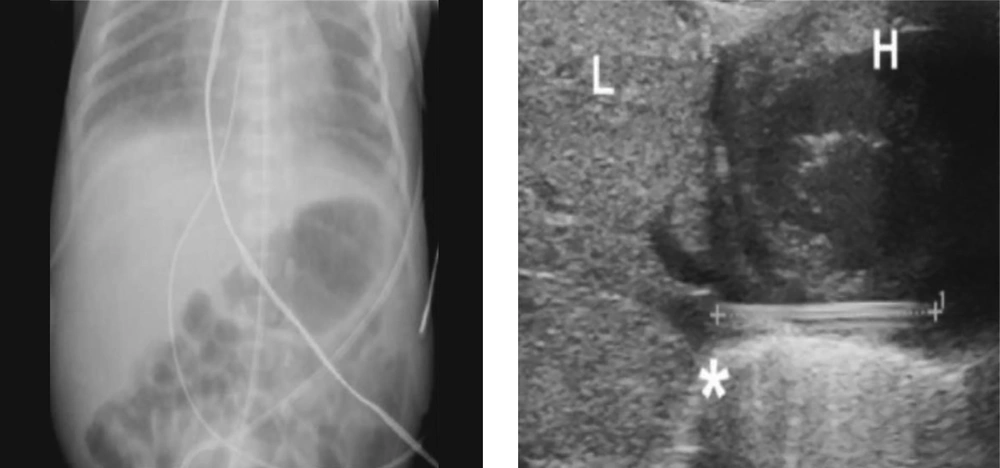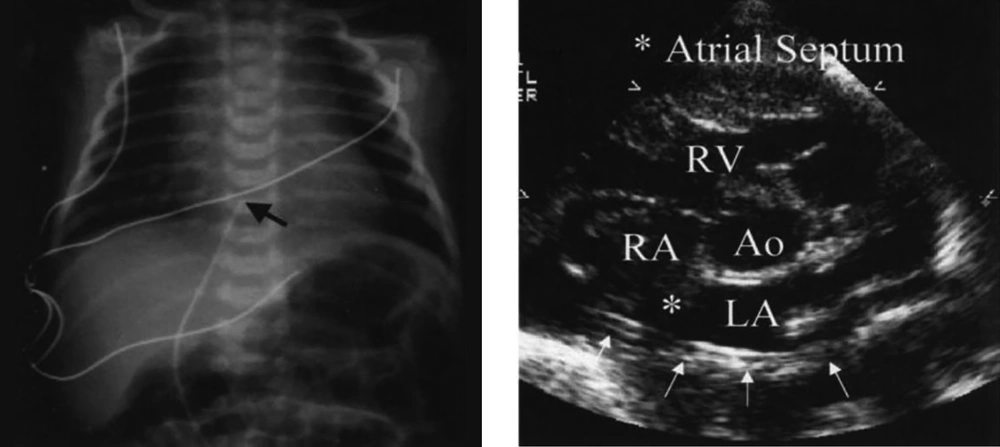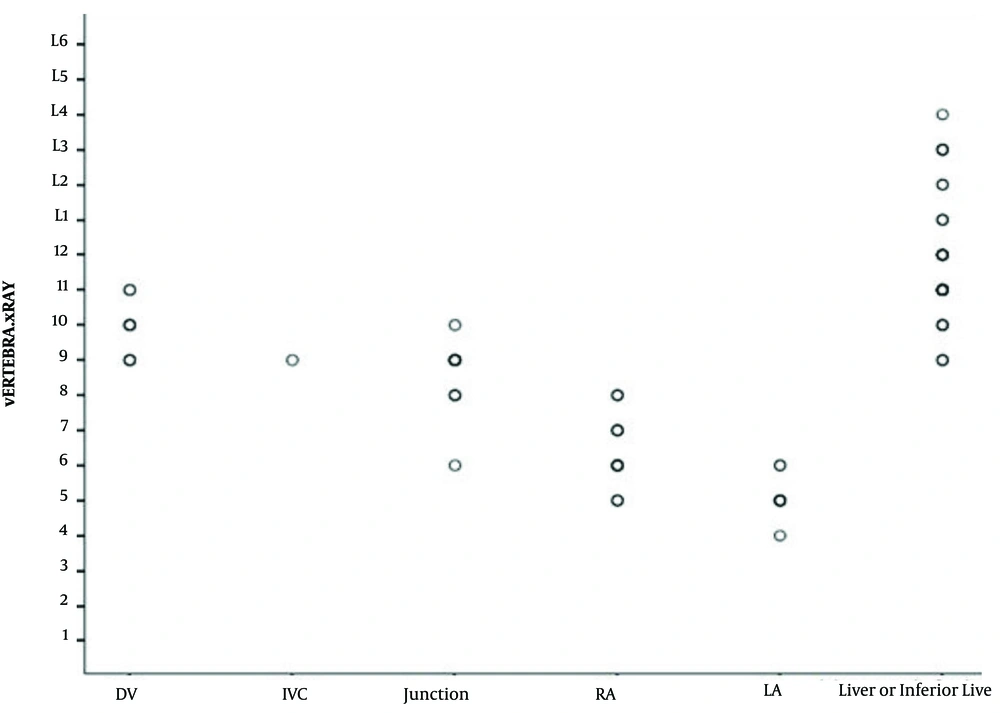1. Background
The umbilical vein catheterization (UVC) is usually performed in ill or preterm neonates in neonatal intensive care unit (NICU) (1). It was first used for blood transfusion in 1947 by Diamond (2). Nowadays, it is also used to administer medication, fluid and nutrition, and also to measure blood gases, electrolytes and central venous pressure in premature neonates (3, 4).
Some complications were reported for incorrect position of UVC, such as infection, hepatic necrosis, pericardial and pleural effusions, peritoneal fluid collections, thrombosis, embolism, endocarditis, cardiac arrhythmias, cardiac tamponade, and pulmonary infarction that can lead to life-threatening complications in 0.2% - 4% of cases (5).
The junction of inferior vena cava (IVC) and right atrium (RA) are the best places for UVC tip, with minim complications (6). Although the clinical experts can use a formula to identify the appropriate length of UVC (7), there is a possibility that the catheter tip might not enter the exact place due to umbilical vascular malformation or various pathologies of the thorax or liver (1). Thus, UVC tip position must be verified by effective monitoring technique after its insertion (8). Nowadays, thoraco-abdominal radiography (TAR) is frequently used to confirm the correct UVC position (9). Previous studies reported that lateral radiography, ultrasonography, echocardiography might be able to enhance TAR effect when determining UVC tip (10). In a study by Pulickal et al. (11) the sonography or echocardiography was reported to be even more effective than TAR in finding the catheter tip. Ultrasonography was used in 1995 by Greenberg et al. (12), reporting an excellent outcome in the monitoring of UVC tip. On the contrary, Ades et al. (13) reported a poor correlation between radiography and echocardiography in identifying UVC tip position. Since this technique is time consuming and requires additional knowledge, it is not routinely performed (14). Although the previous studies (11, 13) have compared TAR and echocardiography to identify UVC tip position, there is controversy in their results in addition to being conducted on a small sample size of neonates with different heart anatomy due to genetic differences as well as not using any formula and landmark.
2. Objectives
This study aimed to compare the diagnostic accuracy of TAR vs. echocardiography to determine the accurate tip position of UVC.
3. Methods
In this cross sectional study, premature or ill neonates who were < one week old and admitted to NICUs of the two main hospitals in Southern Iran (Namazee and Hafez) between March 2017 and January 2018, requiring UVC placement were included in this study. Exclusion criteria were requiring blood transfusion, resuscitation, and emergency condition for which the catheter tip was inserted only about 2 - 3 cm in the umbilical vein, severe congenital or chromosomal anomalies in neonates, and parents’ unwillingness to take part in the study. Also, the neonates with omphalitis, omphalocele, gastroschisis, necrotizing entrocolitis (NEC), or peritonitis were excluded due to contraindication of UVC insertion. Thus, the sample size was obtained by the census method (n = 104).
At first, the study design was approved by the Institutional Review Board of Shiraz University of Medical Sciences. Informed consent was obtained from the parents of all neonates. Then, a neonatologist filled a form, containing information on neonate’s age, gender, birth weight (BW), gestational age, and associated diseases, such as respiratory distress syndrome (RDS), congenital heart disease (CHD), and pneumonia.
The catheter diameter for the neonates who were less than 1250 g or greater than 1250 g was 3.5 and 5 Fr, respectively. In this study, we used Vygon Company catheter, France. Umbilical vein catheterization was done based on sterile conditions and NICU protocol. The catheter length was calculated based on the Dunn method (15), and also using the diagram as a landmark. Before placement, according to Dunn method, neonatologist measured the distance between the shoulder to the umbilicus, and then the length of the inserted catheter was determined based on the standard curve. After placement, TAR (Amx (4+) GE, Milwaakee, WI, USA Mobile Radiography) in supine position was done to determine the UVC tip position by a dose of 0.005 msv. TAR result was recorded in a form. Repeat TAR was done if the catheter was repositioned. TAR was performed in closest temporal relation to the echocardiographic analysis.
After TAR, echocardiography (Mindray system with a high frequency probe, by subcostal coronal view and bicaval view) was performed by a pediatric cardiologist after the last replacement TAR. The pediatric cardiologist was blinded to the official TAR readings until the end of the study. The time interval between TAR and echocardiography was documented as well as the best view to see the tip. Echocardiography examined UVC tip in the neonates, and the result was recorded in another form. Information like the reason for catheterization, catheter tip position in radiography and echocardiography, catheter tip position with vertebral appendages, length of the inserted catheter, and complications was recorded.
In this study, the correct position for UVC was considered between IVC and RA (IVC-RA junction).
3.1. Statistical Analyses
IBM SPSS Statistics 17.0 was used (IBM Corp., Armonk, NY, USA). Descriptive statistics (mean and standard deviation, and frequency) were used to summarize the demographic data. Moreover, sensitivity and specificity between TAR and echocardiography were compared by McNemar’s test. P value < 0.05 was considered to be statistically significant.
4. Results
The study population was 104 neonates admitted to NICUs of two hospitals in Shiraz, Iran. Demographic characteristics of the involved neonates, including gender, gestational age, birth weight, and neonatal diseased condition, such as RDS, CHD, and others are shown in Table 1.
| Minimum | Maximum | Values | |
|---|---|---|---|
| Quantitative variable | |||
| Gestational age | 25 | 41 | 33.24 ± 4.20 |
| Birth weight | 700 | 4350 | 2034.13 ± 971.64 |
| Qualitative variable | |||
| Neonatal diseased condition | |||
| Prematurity + RDS | 63 (60.58) | ||
| CHD | 19 (18.26) | ||
| Others | 22 (21.16) | ||
| Sex | |||
| Male | 57 (54.80) | ||
| Female | 47 (45.20) |
Participants’ Demographic Characteristics (N = 104)a
Amongst the 104, UVC insertion was evaluated with echocardiography, the catheter tip was in the left atrium (LA) (11 cases), in RA (17 cases), in the IVC-RA junction (15 cases), in IVC (one case), and in the ductus venous (DV) (nine cases), and the remaining cases that were not in these positions were in radiography in the liver or under the liver (Table 2).
| Catheter Tip | Inferior of Liver | Liver | DV | IVC | IVC-RA Junction | RA | LA |
|---|---|---|---|---|---|---|---|
| In TAR | 9 (8.7) | 43 (41.3) | 8 (7.75) | 1 (1) | 15 (14.4) | 24 (23.1) | 4 (3.8) |
| In echocardiography | 51 (49) | 9 (8.7) | 1 (1) | 15 (14.4) | 17 (16.3) | 11(10.6) | |
Catheter Tip Position According to TAR and Echocardiography (N = 104)a
Since the diaphragm was considered as a landmark to determine the catheter tip position in echocardiography and TAR, in the cases that catheter tip was either on top, below or on the diaphragm, were similar in both of them. Our results showed that 30 cases (28.8%) the tip was located on the top of the diaphragm, 62 cases (59.6%) below the diaphragm, and 12 cases (11.6%) on the diaphragm (Figure 1), and the specificity, sensitivity, positive predictive value (PPV) and negative predictive value (NPV) were approximately 100%. Based on the catheter length on the Dunn curve, it was appropriate in 62 cases (59.6%), too deep in eight cases (7.7%), and too shallow in 34 cases (32.7%). The mean of catheter length was 7.82 ± 1.55 cm (4 - 11.5). On the other hand, in 59.6% of cases, catheter tip was correctly inserted while in 40.38% it was not.
Amongst 62 correctly inserted catheter tips, 17 cases were in correct position while 45 cases were in the incorrect position, using echocardiography. Also, among 42 cases where the catheter tip was inserted incorrectly, in eight, it was in the correct position and 34 cases were in the incorrect position (Figure 2). These results indicate that the Dunn curves had the specificity, sensitivity, PPV and NPV of 68%, 43%, 27.4% and 80.9%, respectively.
Based on the Dunn curve, in cases where the length of catheter was correctly inserted, echocardiography showed that the catheter tip was located in RA, LA, and IVC-RA junction (perfect location). However, in cases which the length of the catheter was inserted less than the standard value of the Dunn curve, it was located in the IVC-RA junction, RA, IVC, and DV. Also, in cases in which the length of the catheter was inserted in the upper standard value of the Dunn curve, the tip was located in LA and RA (Table 3).
| DV | IVC | Junction IVC with RA | RA | LA | |
|---|---|---|---|---|---|
| Correct of length catheter | 6 | 0 | 11 | 12 | 7 |
| Upper of length catheter | 0 | 0 | 0 | 3 | 4 |
| Lower of length catheter | 3 | 1 | 4 | 2 | 0 |
Cather Tip Position Based on Dunn Formula
Also, our results revealed that catheters located in the DV, IVC, IVC-RA junction, RA, LA in echocardiography were in TAR equaled to T9-T11, T9, T6-T10, T5-T8, and T4-T6, respectively (Table 4 and Figure 3).
| T4 | T5 | T6 | T7 | T8 | T9 | T10 | T11 | T12-L5 | |
|---|---|---|---|---|---|---|---|---|---|
| DV | - | - | - | - | - | 3 (33.30) | 4 (44.40) | 2 (22.20) | - |
| IVC | - | - | - | - | - | 1 (100) | - | - | - |
| IVC-RA junction | - | - | 1 (6.70) | - | 3 (20) | 10 (66.70) | 1 (6.70) | - | - |
| RA | - | 3 (17.60) | 7 (41.20) | 4 (23.50) | 3 (17.60) | - | - | - | - |
| LA | 1 (9.10) | 8 (72.70) | 2 (18.20) | - | - | - | - | - | - |
| T9-T10 | - | - | - | - | - | 9.89 ± 0.78 | - | ||
| T6-T10 | - | - | 6.80 ± 0.90 | - | - | - | |||
| T5-T8 | - | 9.60 ± 0.10 | - | - | - | - | |||
| T4-T6 | 5 ± 0.53 | - | - | - | - | - | - | ||
Catheter Tip Position by Echocardiography and Vertebral Appendages in TAR (N = 104)
In the present study, McNemar’s test showed that the sensitivity, specificity, PPV, and NPV by TAR and echocardiography to determine the catheter tip in IVC-RA junction and IVC were high (100%), but in RA and LA were low (Table 5).
The Sensitivity, Specificity, PPV, and NPV of Tar to Determine the Catheter Tip by TAR and Echocardiography
5. Discussion
In this study, we showed that echocardiography is as reliable as TAR for determining UVC tip position, and can be suggested as an alternative.
Currently, the best site for UVC is IVC, between the hepatic vein drainage and entry into the RA. In this regard, our results revealed that 24.1% of the catheter tips in echocardiography were in an acceptable position (DV, IVC or IVC-RA junction). However, Harabor et al. (16) showed that in 57% of 51 neonates, UVC was in acceptable position, in the supra-hepatic IVC up to RA entry while Ades et al. (13) revealed that in 23% of 53 cases, the catheter tip was in the RA. These differences can be related to the different type and size of their samples, or the equipment and setting in different countries.
Moreover, our results revealed that radiography had acceptable sensitivity and specificity in determining the tip of UVC, except for the atrium, but echocardiography was almost more standard. These findings confirm our hypothesis, which is in line with the result of a comparative study that revealed a sensitivity, specificity, PPV, and NPV of 86%, 75%, 90%, and 67%, respectively based on the house staff physicians’ ability to discriminate malpositioned catheter from an ideally placed catheter in echocardiography (11). However, Karber et al. (1) and Harabor et al. (16) did not report sensitivity or specificity of the diagnostic methods in their study.
In our study, catheters located in DV, IVC-RA junction, RA, LA in echocardiography were in TAR equaled to T9-T11, T6-T10, T5-T8, and T4-T6, respectively. Also, all catheters located below T12 were inside the liver or under the liver, and all those located at T4-T5 were in the arteries and heart. Therefore, the ideal position was the IVC-RA junction, which could be from T6 to T10, but its mean value was 8.6 ± 0.9 (T8-T9). However, the catheter tip position at acceptable positions (DV, IVC, and IVC-RA junction) can be between the T6 and T10 (17). In this regard, Pulickal1 et al. (11) showed that all catheters at T6 and other vertebrae above it were in the heart; 58% catheters were located in the LA. At T7, 82% of catheters were incorrectly positioned with the tip in RA. At T8-T9, 90% catheters were correctly positioned at the IVC-RA junction, 100% at T9. All catheters at T11 and other vertebrae under it were in the liver proximal to the DV (11). TAR is a valid tool for a skilled person to determine the catheter tip with radiography based on diaphragmatic landmarks, vertebrae and chest anatomy, but in cases that the catheter tip is in the LA, TAR cannot detect it well. Therefore, echocardiography is more accurate than TAR. In addition, echocardiography is cheaper, lacks radiation, and more importantly, it can be simultaneously performed with a catheter insertion and quickly diagnose the complications. In TAR method, since the actual position of the catheter tip cannot be determined, radiography must be frequently taken (12); thus, this method is time-consuming and costly. However, we should consider the shortcoming of echocardiography, such as the essential need of pediatric cardiologist to be available all the time, which is a difficult condition in most neonatal centers in the developing world, while TAR results could be evaluated by most neonatologists who are available at all time. This issue can be resolved by training a neonatal specialist in a hospital. Therefore, using echocardiography is preferred over radiography when a pediatric cardiologist or trained neonatologist is within reach.
In addition, our results indicated that the Dunn curve had poor specificity, sensitivity, PPV and NPV. Furthermore, a study conducted by Shukla et al. (17) showed that the catheter tip was inserted based on the Dunn method, which was not accurate and caused over-insertion or low position in the liver. In addition, they stated that the length of the inserted catheter is more accurate based on BW and suggested the following formula 1 + (3 + BW + 9)/2. Then, in a study by Verheij et al. (9), Shukla formula was revised due to excessive insertion of the catheter tip and proposed the (3 + BW + 9)/2 Formula. This formula reduced the over-insertion from 73% to 53%.
In our study, it seems that neither the Dunn nor any other formula is precise or accurate as much as monitoring the catheter tip at the time of the UVC insertion by the echocardiographist. Due to different anatomical position in the umbilical vein as well as the pathological conditions in respiratory diseases can alter structure and/or function of heart and the diaphragm (18), however, a single formula cannot be determined.
5.1. Strengths and Limitations
In the present study, there were several limitations. Importantly, we cannot generalize our results to other populations. Therefore, it is suggested to evaluate these results in other parts of Iran. Another limitation was small sample size and the absence of Wright’s formula or other formulas in our evaluation beside Dunn method. Thus, it is recommended to conduct a larger trial in order to identify the possibility of replacing TAR assessment of UVC position via echocardiography as well as using another formula. Despite these limitations, we had a pediatric cardiologist available during the study period; thus, TAR and echocardiography have been performed in a close time interval. Moreover, this study can improve the diagnosis of catheter tip in infants by simultaneous use of the aforementioned methods, using the diagram as a landmark.
5.2. Conclusions
Our study suggests that echocardiography is as reliable as TAR for early identification of catheter tip position, which can help to avoid complications of catheter malposition. Therefore, it is better to favor it when it is within reach of a pediatric cardiologist or trained neonatologist to reduce repeated radiography.



